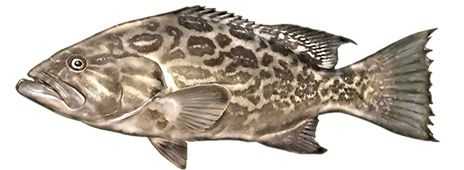Broomtail Grouper

Species Details
Mycteroperca Xenarcha
Serranidae
Perciformes
Offshore, Deepwater, Reefs
30 - 60 lbs.
25" - 59"
Broomtail Grouper (Mycteroperca Xenarcha) Description
The Broomtail Grouper is another member of the grouper family known for its broom-like tail fin. Its tail fin – unlike other groupers – looks more like a fan rather than the usual square-edged ones its cousins have. However, some people still manage to mistake it for looking like a Gag Grouper or a Black Grouper. The best way to tell them apart is via their tails. The Broomtail Grouper is called what it is for a reason.
Its snout extends past its eye and has a bit of an underbite, revealing some canine-like teeth. Broomtail Groupers are oval-shaped and quite robust, making them a mighty catch and a meaty fish. Usually, the Broomtail Grouper comes in pale brown with dark brown lips-shaped kiss marks. However, there have been some reports that Broomtail Groupers also have a gray variant.
Diet and Size
Broomtail Groupers, although they have large mouths, in reality, are not that picky. Oftentimes, anglers would lure them with their favorites such as crustaceans like shrimp or even an occasional squid. As a grouper, the Broomtail Grouper will also have a preference for live bait. So, what some anglers do is that they catch one of the smaller ones first where the Broomtail Groupers are and lure them with it.
On average, a Broomtail Grouper weighs between 30 to 60 lbs. As for length, they range between 25 to 59 inches. Usually, the ones people catch are around 2 feet. The biggest Broomtail Grouper so far was around 4 feet and 10 inches.
Interesting Facts about the Broomtail Grouper
- Like their other Grouper cousins, Broomtail Groupers can be quite opportunistic when it comes to their food.
- Broomtail Groupers are considered rare in North America. However, they are quite bountiful in South American waters.
- Broomtail Groupers are currently vulnerable to being overfished.
- Broomtail Groupers have soft meat.
- People love fishing for a Broomtail Grouper due to the challenge it gives them.
Fishing Techniques: How to Fish for a Broomtail Grouper
Keep your guard up. The first thing you do is make sure you have heavy tackle and that you keep your guard up. The moment you let your guard down, your rod may as well sock you in the gut. Although Broomtail Groupers don’t have much stamina, they still have a lot of strength. Along with their average weight being around 100 lbs, expect to be struggling and fighting with the large fish.
Like their other grouper cousins, the Broomtail Grouper will try to drag you around the moment it bites something. It’s an opportunistic fish, what did you expect? The Broomtail Grouper once it’s assured its catch will drag the bait (and indirectly you) into the rocks. However, you have to make sure that you yourself don’t piledrive straight into the rocks or lose that line.
For equipment, it's an advantage to bring out a braided line when catching a Broomtail Grouper. This prevents the line from snapping especially if when they break off for their initial run. It also doesn't stretch as much so when you snag that Broomtail Grouper, you're assured that your line doesn't snap right away. Another must-have is to have a reel that has a good drag. Reels with good drags are the kinds of reels that can create enough friction to make sure your line doesn't snap. It also gives you enough time to reel back the fist even if it's struggling. Usually, this kind of heavy equipment is needed if you're going after the bigger fish. But you can also use a medium tackle when fishing for smaller ones that roam around the estuaries.
For lures, the best one to use is a jig. The jig will help you get the bait down quickly since the Broomtail Grouper is more of a ground-type fish. Jigs will make sure your baits get to the bottom and it'll also save you some time in getting it down there. Once you choose your jig, next is your bait. Although they have large mouths, they're not entirely picky. They're only picky on whether or not the bait is dead or alive. They love live bait. Some anglers recommend using crustaceans such as live shrimp to catch their attention. But best to use some of the fish in the area like maybe a Minnow or a Pinfish, so long as it's alive. They do quite well with squids too.
Put up some resistance and quickly try to bring them up. Once you feel their speed weakening, that’s when you pull them upward for a haul.
Habitat and Distribution
The Broomtail Grouper however is a rare fish, especially in Eastern California. Most of the time, they’re more available in the South American waters such as water bodies near Peru. Broomtail Groupers often lurk in the deeper waters but some do make their way to estuaries and mangrove swamps. Broomtail Groupers are often more numerous in the Mexican Pacific where there are a lot of rocks. As Grouper, they will often stay in rocky continental shelves and reefs to hide to ambush their prey.
Younger ones are usually more prone to staying near the surface. Adults on the other hand are usually found staying in 196 feet worth of water.







